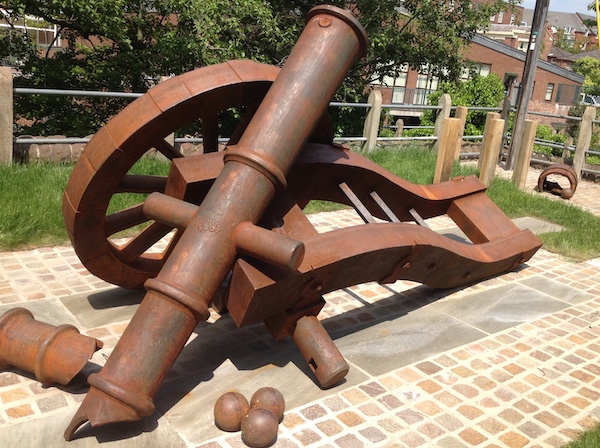Morgan's Mount
Morgan’s Mount is a tower on the north side of Chester's walls that served as an observation platform during the English Civil War. It is the first tower along the walls to the west of the Northgate. It takes its name from a battery of guns situated outside the present walls commanded by a Captain Edward Morgan during the Civil War. It does not appear to have had a name before then. In 1645 the vicinity of Morgan’s Mount was the scene of a particularly violent bombardment during the siege of Chester when the Royalist defendants were driven back for a while into entrenchments dug in the nearby Infirmary field. The Infirmary field, which had also been the site of a Roman cemetery, has since been developed with housing.

During the siege of Chester in 1645, parliamentary forces set up cannons opposite Morgan’s Mount. On 4th October they opened fire and a Royalist cannon on the Mount was destroyed by a 30lb cannon ball. The battlements of the tower were also badly damaged. Below the Mount, just outside the walls there is now a sculpture created by the artist Colin Spofforth. The sculpture represents the destroyed Civil War cannon and is intended to commemorate Chester’s brutal siege and the story of Captain Morgan. Little is known about Captain Morgan except that he stood on the platform to direct firing and that he was killed in 1659 at the Battle of Winnington Bridge, near Northwich.

There are several towers positioned at intervals around Chester’s medieval walls. The towers are of various sizes and heights which suggests that they were constructed at different times as opposed to being built as an overall plan. However, they are all projected forward of the city walls in order to provide flanking cover against attacks on the walls. Some towers are of a quite simple design like Morgan’s Mount, which is a rectangular shape and has a platform one level above the walls walk.

During the days of the Civil War, the Mount was of strategic significance because it offered unobscured views of the immediate vicinity as well as views across the Dee estuary and as far as the hills of North Wales. The present appearance of Morgan’s Mount Tower dates to the 18th century when the walls were repaired, but no longer needed to defend the City. They were therefore converted into a fashionable walkway and tourist attraction. There are now access steps to the platform level but in recent years the panoramic view has been obscured by the growth of trees.

In 1883 during repair works on a length of the City Wall near to Morgan’s Mount, it was noticed that fragments of Roman stonework had been packed into the fill of the lower courses of the walls. Subsequent repair works between Northgate and the King Charles Tower uncovered a number of Roman tombstones which, like the stones found near to Morgan’s Mount, had also been reused to fill the lower part of the wall.
A little to the west of Morgan’s Mount is a modern footbridge that was built in 1966, also known as St. Martin’s Gate, it was here that the Roman wall turned southwards. The Romans built an Angle Tower at the corner where the Roman wall turned southwards. The Angle Tower can no longer be seen but its position has been marked by cobbles in the pavement below the steps of the footbridge.
